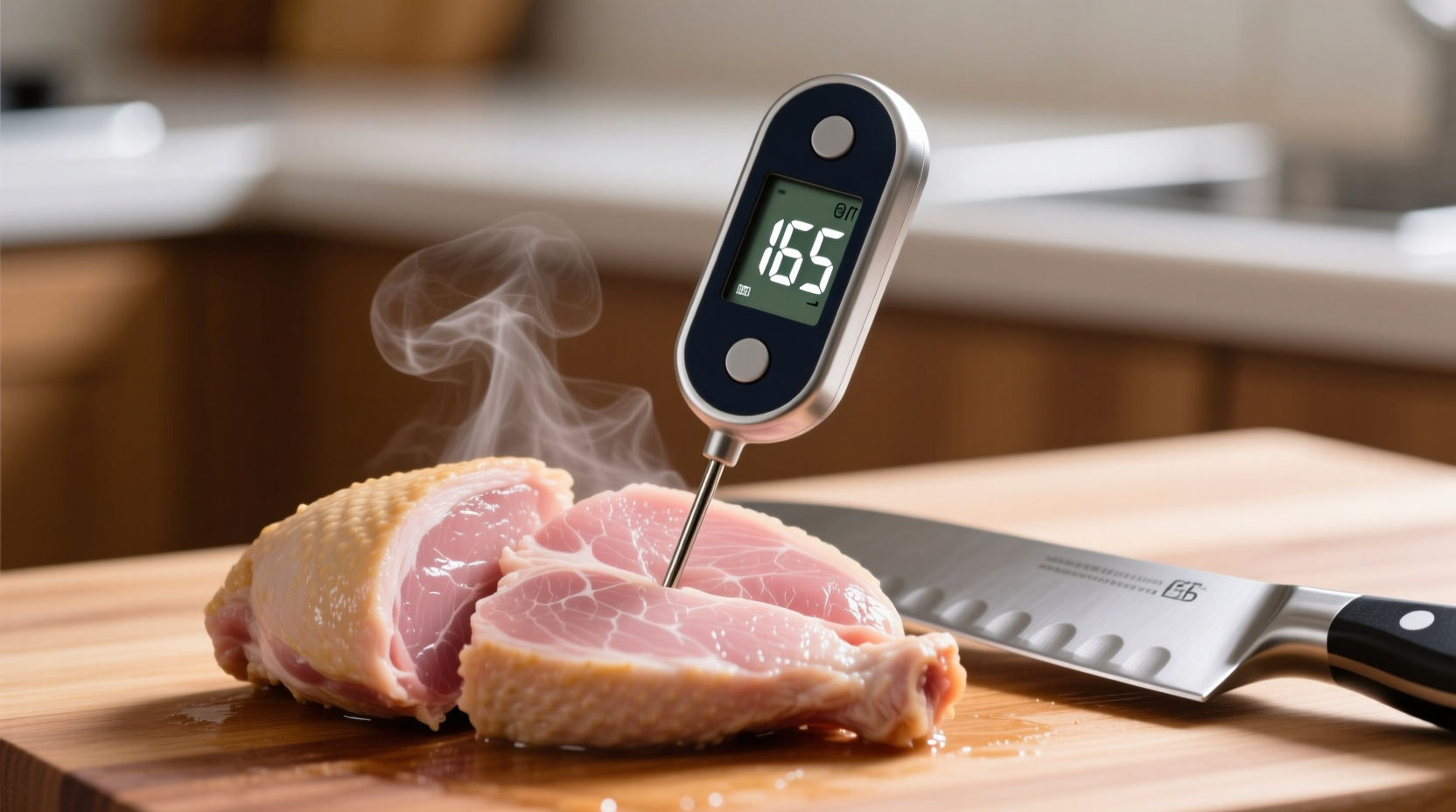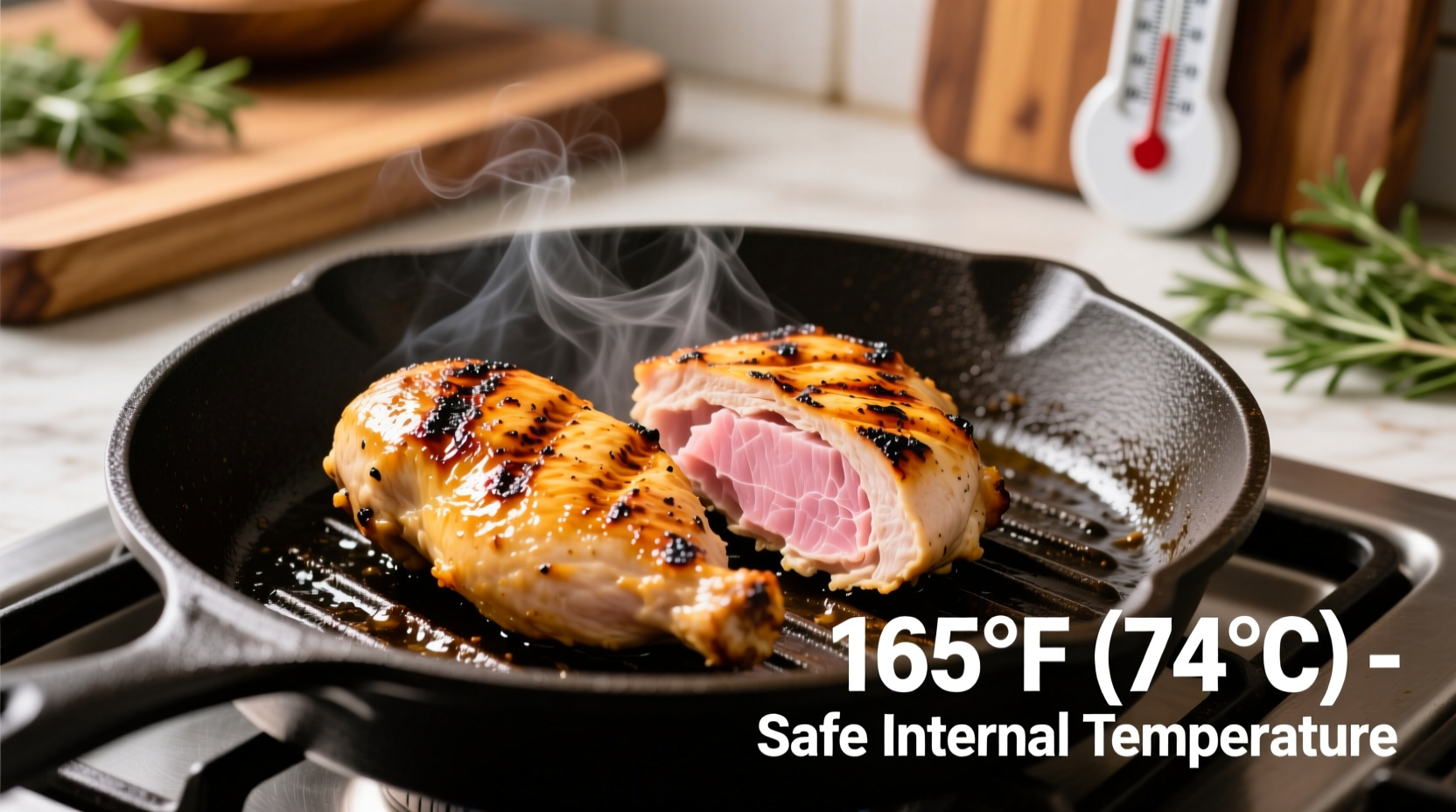The safe internal temperature for cooking all poultry, including chicken breasts, thighs, and whole chickens, is 165°F (74°C) as measured by a food thermometer. This temperature destroys harmful bacteria like Salmonella and Campylobacter, ensuring your chicken is both safe to eat and properly cooked.
Getting chicken temperature right isn't just about avoiding foodborne illness—it's the key to perfectly juicy results every time. Many home cooks rely on color or cooking time alone, but these methods can't guarantee safety. Let's explore exactly what temperature you should cook chicken to and how to achieve restaurant-quality results at home.
Why 165°F Is the Chicken Cooking Standard
For decades, food safety organizations worldwide have established 165°F (74°C) as the minimum safe internal temperature for all poultry. This specific temperature was determined through extensive research on pathogen destruction:
| Organization | Recommended Temperature | Verification Source |
|---|---|---|
| USDA Food Safety and Inspection Service | 165°F (74°C) | Official Guidelines |
| Food and Drug Administration (FDA) | 165°F (74°C) | FDA Food Code |
| Food Standards Agency (UK) | 75°C (167°F) | Scientific Report |
At 165°F, harmful bacteria like Salmonella and Campylobacter are destroyed instantly. Lower temperatures require holding times to achieve the same safety—160°F needs 14.8 seconds, while 150°F requires 2.8 minutes. For practical home cooking, 165°F remains the simplest, most reliable standard.
Chicken Temperature Guide by Cut
Different chicken parts have varying fat content and muscle structure, but they all share the same safe minimum temperature. Here's what you need to know for each cut:
Chicken Breasts
Lean chicken breasts easily become dry when overcooked. Remove them from heat at 160-162°F, as carryover cooking will bring them to 165°F during resting. For best results, use indirect grilling or finish in the oven after searing.
Thighs and Drumsticks
These dark meat cuts can handle slightly higher temperatures without drying out. Cook to 165°F, but they'll remain juicy up to 175°F. The extra fat and connective tissue benefit from the higher heat, becoming more tender.
Whole Chicken
When roasting a whole bird, check multiple spots: the breast, thigh, and center of stuffing if used. The breast will reach temperature first, while the thigh may need additional time. A probe thermometer with multiple sensors makes this process easier.
Ground Chicken
Always cook ground chicken to 165°F. Unlike beef, poultry lacks the protective exterior that keeps pathogens out of the interior, making thorough cooking essential for safety.

How to Measure Chicken Temperature Correctly
Using a thermometer properly is just as important as knowing the target temperature. Follow these steps for accurate readings:
- Placement matters: Insert the thermometer into the thickest part of the meat, avoiding bone, fat, or gristle
- Check multiple spots: Especially with larger pieces or whole birds, verify temperature in several locations
- Wait for stabilization: Leave the thermometer in place for 10-15 seconds to get an accurate reading
- Clean between uses: Sanitize your thermometer when checking different pieces to prevent cross-contamination
Instant-read thermometers provide the most accurate results for chicken. Leave-in probe thermometers work well for roasting but may not be precise enough for thinner cuts like breasts.
Understanding Carryover Cooking
Chicken continues to cook after removal from heat—a phenomenon called carryover cooking. This explains why professional chefs often remove chicken from heat before it reaches 165°F:
- Small cuts (breasts, cutlets): Temperature rises 5-10°F during resting
- Large cuts (thighs, drumsticks): Temperature rises 5-7°F
- Whole chicken: Temperature rises 10-15°F
Rest chicken for 5-10 minutes before serving. This allows juices to redistribute, resulting in moister meat. Tent with foil to retain heat during resting.
Common Misconceptions About Chicken Temperature
Several persistent myths lead to improperly cooked chicken. Let's clarify the facts:
"The juices should run clear"
While clear juices often indicate proper cooking, they're not a reliable safety indicator. Chicken can appear done with clear juices but still harbor dangerous bacteria. Always verify with a thermometer.
"Pink chicken is always unsafe"
Chicken can remain slightly pink even at 165°F due to myoglobin reactions, especially in younger birds or when smoked. Color alone doesn't indicate safety—only a thermometer can confirm.
"I've eaten undercooked chicken before with no issues"
Foodborne illness has an incubation period. Symptoms may not appear for 12-72 hours, making it difficult to connect illness with a specific meal. Consistent safe cooking practices prevent cumulative risk.
Troubleshooting Temperature Issues
Even when following proper temperatures, you might encounter these common problems:
Dry Chicken Despite Correct Temperature
This often happens when chicken is cooked too quickly at high heat. Try these solutions:
- Brine chicken breasts before cooking (¼ cup salt dissolved in 4 cups water for 30 minutes)
- Cook at lower temperatures (325-350°F) for longer periods
- Use a thermometer to remove chicken at 160°F rather than waiting for 165°F
Inconsistent Temperatures Across the Bird
When roasting whole chicken, the breast often cooks faster than the thigh. To address this:
- Tuck wings under the body
- Place breast-side down for the first half of cooking
- Use a spit for even rotation if grilling
- Cover the breast with foil if browning too quickly
When Slightly Lower Temperatures Might Work
For experienced cooks using precise temperature control, lower temperatures with extended holding times can produce juicier results while maintaining safety:
- 150°F for 3 minutes: Suitable for sous vide cooking
- 155°F for 47 seconds: Acceptable for dark meat with proper timing
- 160°F for 14.8 seconds: The absolute minimum for white meat
These methods require specialized equipment and strict timing—most home cooks should stick with the standard 165°F recommendation for simplicity and safety.
Is chicken safe at 160 degrees?
Chicken reaches safe doneness at 160°F only if held at that temperature for 14.8 seconds. For practical home cooking, 165°F is recommended as it provides an instant kill of pathogens without requiring precise timing.
Why is my chicken still pink at 165 degrees?
Pink color in properly cooked chicken (165°F) occurs due to myoglobin reactions, especially in younger birds or when using certain cooking methods like smoking. This doesn't indicate undercooking—the only reliable safety indicator is internal temperature.
How long should chicken rest after reaching 165°F?
Chicken should rest for 5-10 minutes after reaching 165°F. This allows juices to redistribute throughout the meat, resulting in moister, more flavorful chicken. Tent with foil to retain heat during resting.
Can I check chicken temperature with a finger test?
No, the finger test is unreliable for determining chicken safety. Even experienced chefs cannot accurately gauge internal temperature by touch alone. Always use a calibrated food thermometer for chicken to ensure food safety.











 浙公网安备
33010002000092号
浙公网安备
33010002000092号 浙B2-20120091-4
浙B2-20120091-4